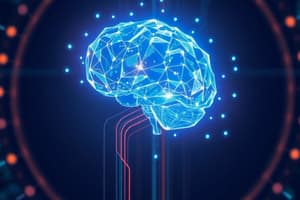Podcast
Questions and Answers
The agent updates the Q-values to converge towards the optimal policy through interaction with the ________.
The agent updates the Q-values to converge towards the optimal policy through interaction with the ________.
environment
Q-Learning algorithm initializes the Q-table with ________ values.
Q-Learning algorithm initializes the Q-table with ________ values.
zero
Q-Learning does not require knowledge of state transitions or the probability of reaching different ________.
Q-Learning does not require knowledge of state transitions or the probability of reaching different ________.
states
Q-Learning works well in environments that are partially observable or ________.
Q-Learning works well in environments that are partially observable or ________.
One significant advantage of Q-Learning is its ________ compared to other reinforcement learning algorithms.
One significant advantage of Q-Learning is its ________ compared to other reinforcement learning algorithms.
The primary objective of Q-Learning is to develop an agent capable of finding the optimal sequence of actions in a given environment to maximize a certain __________.
The primary objective of Q-Learning is to develop an agent capable of finding the optimal sequence of actions in a given environment to maximize a certain __________.
In Q-Learning, the environment is represented as a Markov Decision Process (MDP), consisting of a state space (S) and an action space (A). The state space contains all possible states that the agent can be in, whereas the action space encompasses all the ______ that the agent can choose from.
In Q-Learning, the environment is represented as a Markov Decision Process (MDP), consisting of a state space (S) and an action space (A). The state space contains all possible states that the agent can be in, whereas the action space encompasses all the ______ that the agent can choose from.
The reward function in Q-Learning, denoted as R(s, a), determines the immediate reward received by the agent when performing an action 'a' in state 's'. The ultimate goal is to find a strategy that yields the highest possible cumulative __________ over time.
The reward function in Q-Learning, denoted as R(s, a), determines the immediate reward received by the agent when performing an action 'a' in state 's'. The ultimate goal is to find a strategy that yields the highest possible cumulative __________ over time.
To solve the optimization problem, Q-Learning relies on a Q-table, which maps states to the corresponding optimal __________.
To solve the optimization problem, Q-Learning relies on a Q-table, which maps states to the corresponding optimal __________.
Q-Learning was introduced in ________ by Richard Sutton and Andrew Barto.
Q-Learning was introduced in ________ by Richard Sutton and Andrew Barto.
Study Notes
Understanding Q-Learning in Reinforcement Learning
Q-Learning is a popular algorithm in the field of reinforcement learning, which falls under the broader umbrella of artificial intelligence. Developed by Richard Sutton and Andrew Barto, Q-Learning was introduced in 1992. The primary objective of Q-Learning is to develop an agent capable of finding the optimal sequence of actions in a given environment to maximize a certain reward.
Key Components of Q-Learning
State and Action Space
In Q-Learning, the environment is represented as a Markov Decision Process (MDP), consisting of a state space (S) and an action space (A). The state space contains all possible states that the agent can be in, whereas the action space encompasses all the actions that the agent can choose from. These choices depend on the current state and the desired outcome the agent wants to optimize.
Rewards and Penalties
Another crucial aspect is the reward function, denoted as R(s, a), which determines the immediate reward received by the agent when performing an action 'a' in state 's'. The ultimate goal is to find a strategy that yields the highest possible cumulative reward over time.
Q-Table
To solve the optimization problem, Q-Learning relies on a Q-table, which maps states to the corresponding optimal action. The Q-value represents how much a particular action, given a certain state, contributes towards achieving the maximum reward. Over time, through interaction with the environment, the agent updates the Q-values to converge towards the optimal policy.
Algorithm
The Q-Learning algorithm operates in several steps:
- Initialize the Q-table with zero values.
- Configure parameters such as learning rate (alpha) and discount factor (gamma).
- For a specified number of episodes, perform the following steps:
- Start from a random initial state.
- Evaluate the Q-values of the chosen action for the current state.
- Choose the action with the highest predicted reward using the Q-table.
- Perform the chosen action and receive the resulting state, reward, and terminal status.
- If the terminal status indicates that the episode is still ongoing, go back to step 2. Otherwise, end the episode.
At the end of each episode, the Q-table is updated according to the Bellman equation:
Q(s, a) ← (1 −α) × Q(s, a) + ɑ × (R + γ × max(Q(s', a'))),
where α is the learning rate, γ is the discount factor, R is the reward obtained from the previous action, and max(Q(s', a')) denotes the maximum Q-value among all feasible actions from the next state.
Advantages of Q-Learning
One significant advantage of Q-Learning is its simplicity compared to other reinforcement learning algorithms. It doesn't require knowledge of the state transitions or the probability of reaching different states. Additionally, it works well even in situations where the environment is partially observable or uncertain.
Applications of Q-Learning
Q-Learning has been successfully applied to various domains, including gaming (such as AlphaGo Zero's victory in Go), robotics, and industrial automation. Its versatility makes it an essential tool for developing smart systems that continuously learn and improve their performance.
Studying That Suits You
Use AI to generate personalized quizzes and flashcards to suit your learning preferences.
Description
Explore the key components, algorithm, advantages, and applications of Q-Learning in reinforcement learning, a fundamental concept in artificial intelligence. Learn about the Q-table, rewards, penalties, state and action space, and how the algorithm helps agents optimize actions to maximize rewards.




